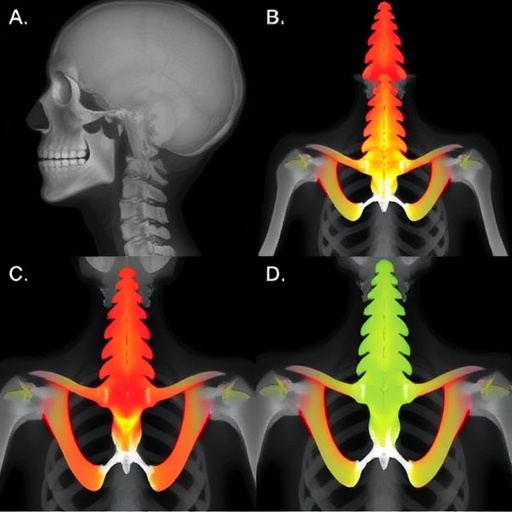In a groundbreaking study published in the esteemed journal Pediatric Radiology, researchers have delved into the intricate world of anatomical variations at the costochondral junction in children under two years of age. This study is particularly significant because the costochondral junction is crucial for understanding various developmental conditions and can influence diagnostic imaging interpretations. As pediatric healthcare evolves, understanding these variations becomes paramount for improving patient outcomes.
The costochondral junction represents the area where the rib cartilage meets the ribs, and this junction plays a pivotal role during the growth and development of a child’s thoracic skeleton. Anomalies here can sometimes lead to complications; they may alter respiratory mechanics or result in additional diagnostic challenges in a clinical setting. For pediatric radiologists, an intricate understanding of these anatomical variations aids in accurate interpretation of radiological scans, ultimately contributing to improved clinical decision-making.
Karmazyn et al.’s study meticulously analyzes imaging data obtained from a diverse cohort of children under the age of two. They employed advanced imaging techniques, including high-resolution ultrasound and computed tomography, to discern not only the standard anatomical configurations but also the rare variations that can occur in the population. This comprehensive approach enhances the robustness of the findings, ensuring that they are applicable across different demographics.
Significantly, the findings reveal that there is a broader spectrum of anatomical variation at the costochondral junction than previously recognized. The research highlights conditions previously thought to be anomalies but are, in fact, common variants observed in young children. By reframing perceptions about these anatomical features, pediatric radiologists and clinicians can enhance their awareness and better tailor their diagnostic strategies.
Moreover, the implications of this research extend well beyond the realm of radiology. Understanding these variations is critical for pediatricians and other healthcare providers involved in diagnosing and managing chest wall abnormalities. By incorporating this knowledge into their assessments, practitioners can improve their diagnostic accuracy and ultimately deliver better patient care.
The data drawn from this study underscores the need for ongoing education and training within the pediatric healthcare community. It serves as a call to action for medical professionals to prioritize familiarization with these nuances that are easily overlooked in routine examinations. Continuing medical education modules and workshops might benefit significantly from incorporating these findings to cultivate a sharper focus on the nuances of early childhood development.
Equally noteworthy is the potential impact of these findings on research and clinical practice. The intricate relationships between anatomical variations and associated clinical manifestations necessitate continued exploration in future studies. Researchers may delve deeper into how variations at the costochondral junction correlate with certain pathologies or how they influence surgical strategies, if surgical intervention becomes necessary.
Furthermore, these revelations highlight the need for enhanced collaboration among interdisciplinary teams, including radiologists, pediatricians, and surgeons. Cross-disciplinary discussions regarding these anatomical variations will undoubtedly foster improved patient management practices. As more pediatric healthcare providers become educated on these anatomical features through collaborative efforts, the conversations about best practices in patient care will no doubt flourish.
With the burgeoning technology in medical imaging and data analysis, the potential for further discoveries in this area is vast. Future studies might even involve genetic sequencing or larger population-based data to elucidate the underlying causes for observed anatomical variations at the costochondral junction. Such advancements can pave the way for personalized medical approaches in treating abnormalities and ensure children receive the most precise care tailored to their developmental needs.
In the age of digital media and information sharing, disseminating findings from studies like Karmazyn et al.’s is paramount. The implications of this research have the potential to go viral, prompting pediatric specialists around the globe to rethink their traditional approaches. Leveraging social media, online seminars, and interactive platforms ensures that this innovative research reaches a wide audience, fostering a community of informed practitioners.
As these conversations continue to percolate through the medical community, there is an opportunity for a paradigm shift in how variations at the costochondral junction are perceived. By integrating this knowledge into daily clinical practice, pediatric healthcare providers can elevate their capacity for high-quality patient-centered care.
In summary, Karmazyn et al.’s research has opened a new chapter in our understanding of anatomical variation within the costochondral junction in infants under two years of age. The implications of these findings extend far beyond academic interest; they significantly influence clinical practice. It is now up to the medical community to heed this enlightening call, redefining norms and enhancing care practices for the youngest patients.
Ultimately, as we pave the way for improved healthcare strategies, it’s essential to remain vigilant in our quest for knowledge. Engaging with research findings and fostering an environment of continual learning ensures that we, as a community, provide the best possible outcomes for our patients. As healthcare professionals, embracing the diversity of anatomical variations only strengthens our capability to adapt and cater to the unique needs of every child we encounter.
Subject of Research: Costochondral junction variations in children under two years of age.
Article Title: Costochondral junction variations in children younger than 2 years.
Article References:
Karmazyn, B., Jones, M.M., Delaney, L.R. et al. Costochondral junction variations in children younger than 2 years. Pediatr Radiol (2025). https://doi.org/10.1007/s00247-025-06316-0
Image Credits: AI Generated
DOI: https://doi.org/10.1007/s00247-025-06316-0
Keywords: Costochondral junction, anatomical variations, pediatric radiology, chest wall abnormalities, medical imaging.




